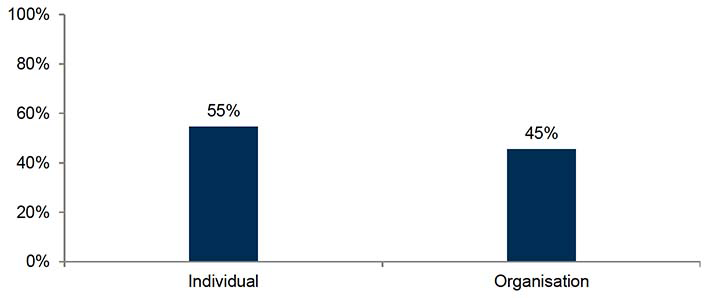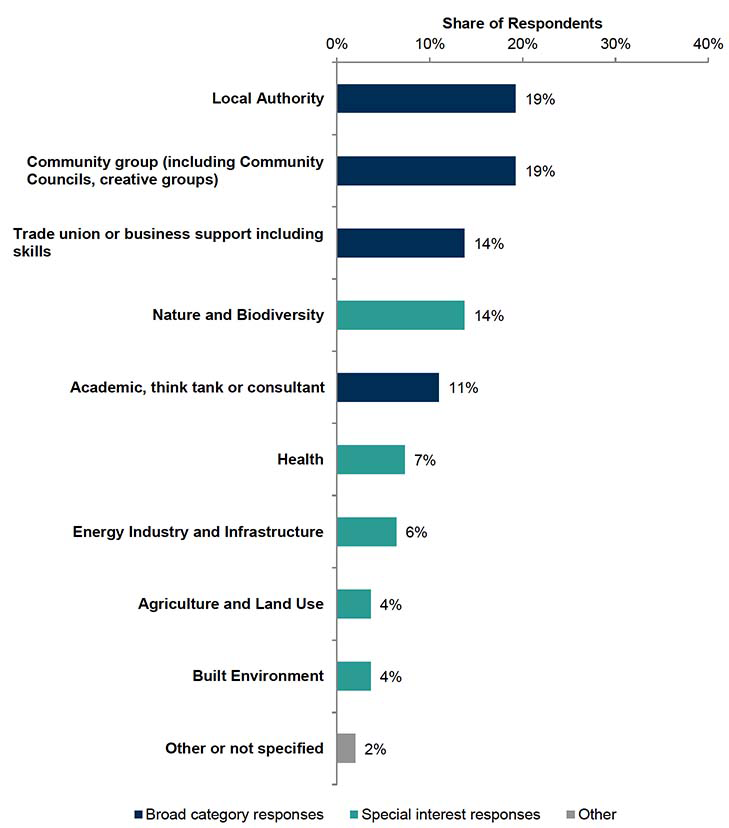Climate change - draft Scottish national adaptation plan 3 2024 - 2029: consultation analysis
Analysis of responses to consultation on the draft Scottish National Adaptation Plan 3 (SNAP3) 2024 to 2029.
Research approach
Overview of responses received
The written consultation remained open for submissions from 31st of January 2024 to 24th of April 2024 and received 240 responses. The majority of responses (91%, 218 respondents) were submitted through the online platform Citizen Space, while 22 responses (9%) were received directly via email. Considering respondent types, 131 (55%) responses were submitted by individuals and 109 (45%) were submitted by or on behalf of organisations. Three responses were excluded from the analysis due to blank or duplicate entries.

The vertical axis above refers to the share of respondents. The 109 respondents answering on behalf of an organisation were grouped according to the following categories:
Broad category responses
- Local Authority
- Community group (including community councils, creative groups)
- Academic, think tank or consultant
- Trade union or business support including skills
Special interest responses[4]
- Agriculture and Land Use
- Built Environment
- Energy Industry and Infrastructure
- Health
- Nature and Biodiversity
Other
- Other or not specified
Detailed breakdowns of responses by respondent type can be found in the following chart:

Written summaries from a further 16 engagement events were also analysed for this report. These events included workshops funded by the Scottish Government and facilitated by the Scottish Government and the Adaptation Scotland Programme. Events were managed by the sustainability charity Sniffer and the Scottish Government’s Climate Action Hubs, as well as a number of other external stakeholders. The workshops were organised with the aim of capturing the views of those with lived experiences or those with technical expertise relevant to the draft Adaptation Plan. The lived experience events covered a diverse set of geographical areas across Scotland such as Glasgow, South Uist, the Highlands, Angus, and Dumfries and Galloway, offering engagement opportunities for local communities. Technical workshops provided engagement with stakeholders from business and industry, local authorities, and land and marine related stakeholders.
Methodology
The written consultation included one demographic question, 31 open-text questions, and five closed consultation questions.[5] The closed consultation questions consisted of four single-choice questions and one multiple-choice question which allowed respondents to select one or more answer options. Open-text responses had a limit of 1,000 characters set for each answer.
All written consultation responses, including online and email responses, were analysed in full. Written responses were merged into one dataset for analysis. Email responses which mapped directly to the consultation questions were included in the analysis of Citizen Space answers. The quantitative data from the closed questions was cleaned and analysed using the programming language Python. The following report presents descriptive breakdowns and charts for each closed question, distinguishing between answers from individuals and organisations. Detailed breakdowns, including distinctions between types of organisations, are available in Appendix A.[6]
All contributions from public and technical workshops were summarised in workshop reports which were used for the analysis in this report. In public workshops, a similar set of questions was asked across different locations where workshops took place. Technical workshops followed no set structure to enable capturing tailored technical expertise on the draft Adaptation Plan.
A thematic analysis of the written consultation’s qualitative, open-text responses as well as email and workshop contributions was then conducted to identify and report common patterns and themes in the responses. This thematic analysis followed the approach suggested by Braun and Clarke (2006), structured as follows:
- Free-text responses were manually reviewed to highlight patterns and recurring themes as well as to identify ideas or perspectives not raised in other responses.
- Qualitative themes were mapped to the open-text question with a narrative description developed for each theme.
- Themes were triangulated and their significance was assessed based on the frequency of convergence or divergence of perspectives.
- Outlier responses that do not fit in with the general emerging themes were identified and patterns of non-responses or grievances voiced were analysed.
The main body of this report is structured as follows, namely: (i) lived and local experience; (ii) outcome one: nature connects; (iii) outcome two: communities; (iv) outcome three: public services and infrastructure; (v) outcome four: economy, business and industry; (vi) outcome five: international action; (vii) enabling factors; and (viii) impact assessments. Subsequently, the thematic analysis of workshops and consultation events is discussed jointly with unstructured email responses from stakeholder organisations.
Limitations
Consultations are a valuable tool to gather the opinions and expertise of relevant stakeholders. However, it is important to note that this report summarises the views of only those who chose to participate in this consultation. Consequently, opinions and results from this consultation can only be understood as indicative rather than representative of the wider population. Those who did participate are more likely to represent an interested subset of the population or to consider themselves more affected by the Adaptation Plan. Respondents may also represent an engaged and, at times, more knowledgeable subset of the population or submit answers to voice specific views or grievances. The timing of the consultation period also coincided with higher-than-usual media coverage of climate change, given the Scottish Government’s announcement of plans to adjust interim emissions reduction targets.
It should also be noted that only a small number of organisations from each detailed respondent type answered the consultation. Consequently, percentages of responses by detailed respondent type in the appendix and for quantitative questions should only be interpreted as indicative. In addition, frequent response rates below ten responses per group per question should not be understood as representative of wider views held by respective sectors.
Similar limitations apply to participants of the consultation events and workshops. This report will present only the analysis of the views of those having chosen to attend the events which are summarised in the workshop reports. No specific information is available on who attended each event, preventing a detailed disaggregation by type of attendee, their affiliations, and what information was contributed by whom.
Contact
There is a problem
Thanks for your feedback